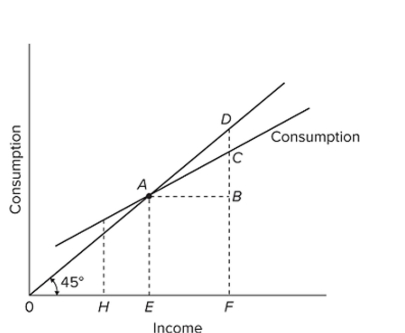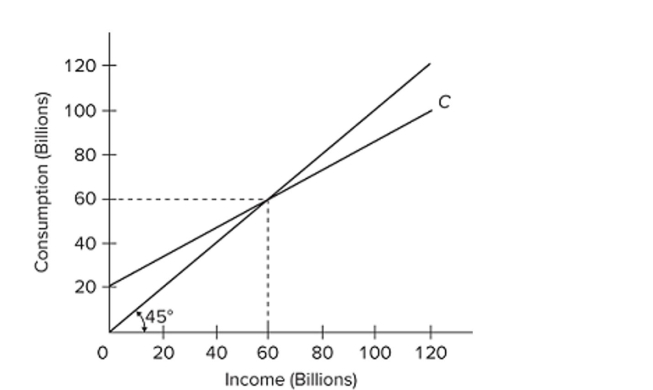A) $430.
B) $450.
C) $460.
D) $470.
Correct Answer

verified
Correct Answer
verified
Multiple Choice
 Refer to the given consumption schedules. DI signifies disposable income and C represents consumption expenditures. All figures are in billions of dollars. At an income level of $40 billion, the
Average propensity to consume
Refer to the given consumption schedules. DI signifies disposable income and C represents consumption expenditures. All figures are in billions of dollars. At an income level of $40 billion, the
Average propensity to consume
A) is highest in economy (1) .
B) is highest in economy (2) .
C) is highest in economy (3) .
D) cannot be determined from the data given.
Correct Answer

verified
Correct Answer
verified
Multiple Choice
 Refer to the given diagram. At income level F, the volume of saving is
Refer to the given diagram. At income level F, the volume of saving is
A) BD.
B) AB.
C) CF − BF.
D) CD.
Correct Answer

verified
Correct Answer
verified
Multiple Choice
As disposable income increases, consumption
A) and saving both increase.
B) and saving both decrease.
C) decreases and saving increases.
D) increases and saving decreases.
Correct Answer

verified
Correct Answer
verified
Multiple Choice
(Advanced analysis) Assume the following consumption schedule: C = 20 + 0.9Y, where C is consumption and Y is disposable income. At an $800 level of disposable income, the level of saving is
A) $180.
B) $740.
C) $60.
D) $18.
Correct Answer

verified
Correct Answer
verified
Multiple Choice
At the point where the consumption schedule intersects the 45-degree line,
A) the MPC is 1.00.
B) the APC is 1.00.
C) saving is equal to consumption.
D) the economy is in equilibrium.
Correct Answer

verified
Correct Answer
verified
Multiple Choice
Which of the following statements about consuming in excess of one's disposable income is not true?
A) It is possible, and it's called dissaving.
B) In this case, the values of both saving and the APS are negative.
C) (APC + APS) will be less than 1 in this situation.
D) The value of APC will be greater than 1 in this case.
Correct Answer

verified
Correct Answer
verified
Multiple Choice
 Refer to the given figure. If the relevant saving schedule were constructed,
Refer to the given figure. If the relevant saving schedule were constructed,
A) saving would be minus $20 billion at the zero level of income.
B) aggregate saving would be $60 at the $60 billion level of income.
C) its slope would be 1/2.
D) it would slope downward and to the right.
Correct Answer

verified
Correct Answer
verified
Multiple Choice
The multiplier is
A) 1/MPC.
B) 1/(1 + MPC) .
C) 1/MPS.
D) 1/(1 − MPS) .
Correct Answer

verified
Correct Answer
verified
Multiple Choice
The MPC can be defined as the
A) change in consumption divided by the change in income.
B) change in income divided by the change in consumption.
C) ratio of income to saving.
D) ratio of saving to consumption.
Correct Answer

verified
Correct Answer
verified
Multiple Choice
Refer to the given data for a hypothetical economy. If plotted on a graph, the slope of the saving schedule would be
A) 0.80.
B) 0.10.
C) 0.20.
D) 0.15.
Correct Answer

verified
Correct Answer
verified
Multiple Choice
Refer to the given data. The marginal propensity to consume is
A) 0.25.
B) 0.75.
C) 0.20.
D) 0.80.
Correct Answer

verified
Correct Answer
verified
Multiple Choice
Refer to the given table, which illustrates the multiplier process. The marginal propensity to save is
A) 0.5.
B) 0.25.
C) 0.2.
D) 0.1.
Correct Answer

verified
Correct Answer
verified
Multiple Choice
Refer to the given data for a hypothetical economy. The marginal propensity to consume is
A) 0.80.
B) 0.75.
C) 0.20.
D) 0.25.
Correct Answer

verified
Correct Answer
verified
Multiple Choice
The practical significance of the multiplier is that it
A) equates the real interest rate and the expected rate of return on investment.
B) magnifies initial changes in spending into larger changes in GDP.
C) keeps inflation within tolerable limits.
D) helps to stabilize the economy.
Correct Answer

verified
Correct Answer
verified
Multiple Choice
The multiplier can be calculated as
A) 1/(MPS + MPC) .
B) MPC/MPS.
C) 1/(1 − MPC) .
D) 1 − MPC = MPS.
Correct Answer

verified
Correct Answer
verified
Multiple Choice
The fraction, or percentage, of total income which is consumed is called the
A) break-even income.
B) consumption schedule.
C) marginal propensity to consume.
D) average propensity to consume.
Correct Answer

verified
Correct Answer
verified
Multiple Choice
Given the expected rate of return on all possible investment opportunities in the economy,
A) an increase in the real rate of interest will reduce the level of investment.
B) a decrease in the real rate of interest will reduce the level of investment.
C) a change in the real interest rate will have no impact on the level of investment.
D) an increase in the real interest rate will increase the level of investment.
Correct Answer

verified
Correct Answer
verified
Multiple Choice
If the real interest rate in the economy is i and the expected rate of return on additional investment is r, then, other things equal,
A) more investment will be forthcoming when i exceeds r.
B) less investment will be forthcoming when r rises.
C) r will fall as more investment is undertaken.
D) r will exceed i at all possible levels of investment.
Correct Answer

verified
Correct Answer
verified
Multiple Choice
Refer to the given table, which illustrates the multiplier process. The total change in consumption resulting from the initial change in investment will be
A) $100.
B) $96.
C) $180.
D) $80.
Correct Answer

verified
Correct Answer
verified
Showing 61 - 80 of 233
Related Exams